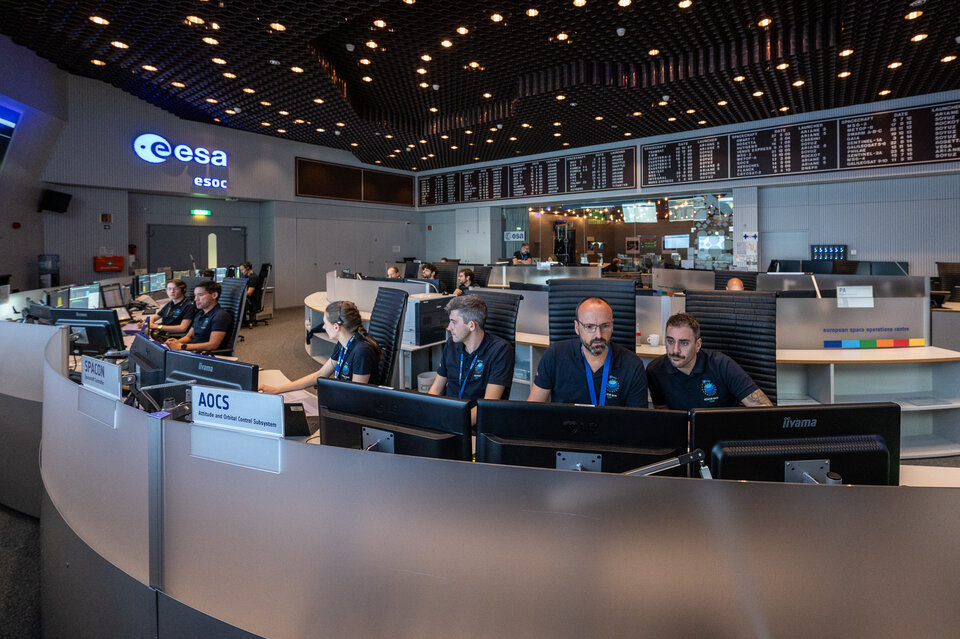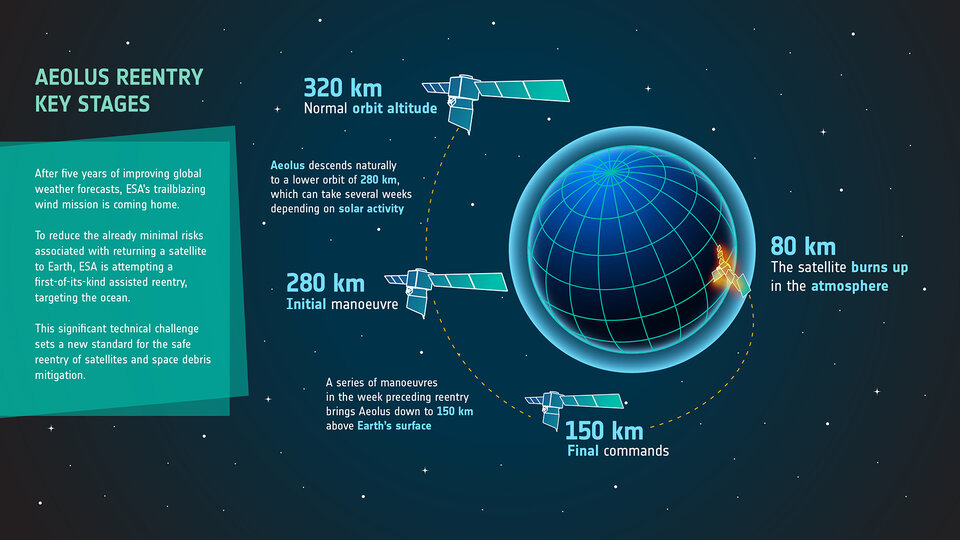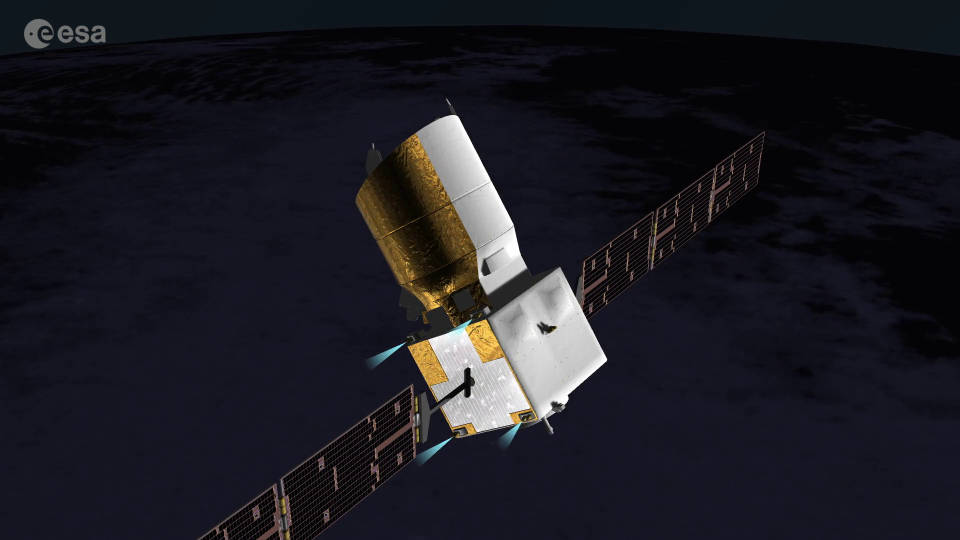Publié le 29 juillet 2023
Aeolus – ESA’s wind mission – reentered Earth’s atmosphere on 28 July at around 21:00 CEST above Antarctica, confirmed by US Space Command.
The reentry comes after a series of complex manoeuvres that lowered Aeolus’ orbit from an altitude of 320 km to just 120 km to reenter the atmosphere and burn up.
Crucially, these manoeuvres – the first assisted reentry of its kind – positioned Aeolus so that any pieces that may not have burned up in the atmosphere would fall within the satellite’s planned Atlantic ground tracks.

Assisting reentry for Aeolus
Today, satellite missions are designed according to regulations that require them to minimise the risk of causing damage on their return to Earth. This would typically be achieved by the majority of the satellite burning up on reentry or through a controlled reentry at the end of their lives in orbit.
However, when Aeolus was designed back in the late 1990s no such regulations were in place.
So, after running out of fuel and without intervention, Aeolus would have reentered Earth’s atmosphere naturally within a few weeks from now – but with no control over where this would happen.
Satellites and rocket parts fall back to Earth roughly once a week, and pieces that survive have only very rarely caused any damage, so the risk of Aeolus causing harm was always incredibly small. In fact, the chance of being struck by a piece of debris is three times less than being struck by a meteorite.
Nevertheless, the European Space Agency (ESA) went above and beyond for Aeolus and attempted a new way of assisting its reentry to make it even safer.

Key stages in Aeolus’ reentry
Essentially trying to make a satellite do what it was never designed to do involved a huge amount of thinking and a lot of planning.
Then, over the last week, the team of spacecraft engineers, flight dynamics experts and space debris specialists at ESA’s ESOC mission control centre in Germany set to work. They used the satellite’s remaining fuel to carry out a series of burns to lower Aeolus and place it into the best position to reenter.
And they pulled it off – with Aeolus reentering in line with current regulations.
ESA’s Director of Operations, Rolf Densing, said, “The teams have achieved something remarkable. These manoeuvres were complex, and Aeolus was not designed to perform them, and there was always a possibility that this first attempt at an assisted reentry might not work.
“The Aeolus reentry was always going to be very low risk, but we wanted to push the boundaries and reduce the risk further, demonstrating our commitment to ESA’s Zero Debris approach.
“We have learned a great deal from this success and can potentially apply the same approach for some other satellites at the end of their lives, launched before the current disposal measures were in place.”

Aeolus reentry: the breakdown.
Access the video here!
This assisted reentry is just one part of ESA’s wider commitment to the long-term safety and sustainability of space activities. By 2030, all ESA missions will be ‘debris neutral’ – thanks to the Zero Debris Charter, the Agency is making sure the technology is ready not just for present-day regulations, but to make possible even more ambitious rules for the future.
From deorbiting kits launched with missions to bring them down safely, to flagship missions like Clearspace-1 that will capture stranded spacecraft in orbit and technologies to limit risks on the ground, ESA is leading the way in sustainable space.
Aeolus: the impossible mission
Aeolus has been a challenging mission – its pioneering laser technology took many years to develop. But after a number of setbacks, Aeolus was finally launched in 2018 to profile Earth’s winds and went on to be one of ESA’s most successful Earth observation research missions.
Aeolus carried an instrument known as Aladin, which is Europe’s most sophisticated Doppler wind lidar flown in space.
Its laser fired pulses of ultraviolet light towards Earth’s atmosphere. This light bounced off air molecules and particles such as dust in the atmosphere. The small fraction of light that scattered back towards the satellite was collected by a large telescope.
Through the measurement of the Doppler shifts in the return signals, the horizontal speed of the wind in the lowermost 30 km of the atmosphere was derived, making Aeolus the first satellite mission to deliver profiles of Earth’s wind on a global scale.
The mission, an ESA Earth Explorer research mission, was designed to demonstrate that this technology was feasible – but it did more than that.

Aeolus reveals all
Access the video here!
ESA’s Director of Earth Observation Programmes, Simonetta Cheli, said, “Aeolus has been truly outstanding. Indeed, the technology was difficult to develop but we have seen huge returns.
“It not only benefited science in terms of contributing to climate research, but its data were used operationally in weather forecasts, which proved essential during the Covid lockdown when aircraft, which carry weather instruments, were grounded.
“A 2022 report by London Economics found that Aeolus also brought real economic benefits – as much as €3.5 billion over the lifetime of the mission.
“We are extremely proud of Aeolus and the many people who made its development, its life in orbit, its data use and its safe end possible.
“And now, with the experience gained from the first Aeolus, our focus turns to its follow-on, Aeolus-2, which is an operational meteorological mission we are developing with Eumetsat, Europe’s Organisation for the Exploitation of Meteorological Satellites.”
Source:
Aeolus: a historic end to a trailblazing mission. (2023, July 29). ESA Observing the Earth.